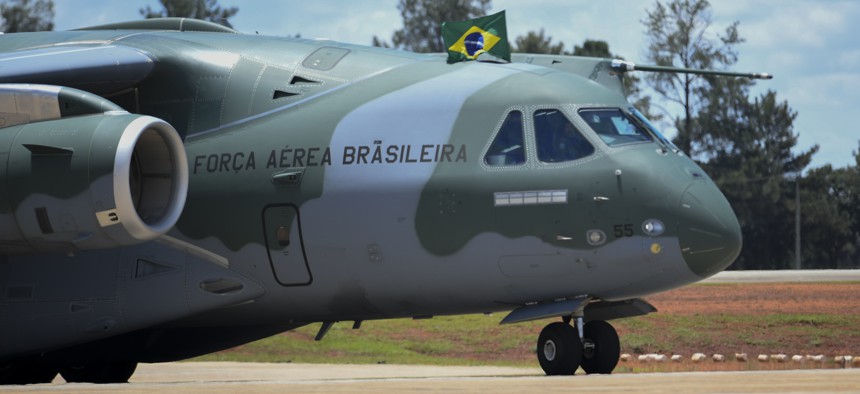
A Brazilian Air Force KC-390 plane arrives with people who resided in Ukraine that were rescued in Operation Repatriation. Mateus Bonomi/Anadolu Agency via Getty Images
L3Harris to Convert Embraer KC-390s for Aerial Refueling
The three-year-old twinjet will be an “agile tanker,” L3Harris CEO says.
L3Harris Technologies has entered an agreement with Brazil’s Embraer to convert KC-390 cargo planes into aerial tankers that can refuel U.S. combat planes in flight.
The goal is to create a tactical tanker that can fly closer to the front lines in a war with a peer competitor and refuel all types of U.S. military planes , according to L3Harris Chairman and CEO Chris Kubasik.
“I think it's going to fill a gap for the Air Force,” Kubasik said in an interview. “Then of course it will have international applications as well.”
The company is calling the aircraft the “Agile Tanker.” Under the teaming agreement announced Monday, L3Harris will soon begin modifications of a Brazilian-made, twin-engine cargo jet, at a factor in Waco, Texas. Kubasik informed Air Force leaders of the company’s plan to build a prototype aircraft during meetings at the Pentagon last week.
L3Harris plans to install a refueling boom and special military communications gear on the planes, Kubasik said. While the KC-390 is already equipped to refuel planes with wing pods, the boom would allow the plane to refuel all types of U.S. Air Force fighter jets, bombers, and transports. Booms can pass jet fuel quicker than the hose-and-basket refueling pods that are used to gas up U.S. Navy fighter jets and some combat planes flown by allies.
The company plans “to start right away,” and hopes to fly the plane with a boom by the end of 2025, Kubasik said, noting that “government money might accelerate that schedule.”
The KC-390 is well suited for the types of conflicts military leaders envision in the future where access to large airfields are more limited either because they are vulnerable to being attacked or have been bombed. Compared to the current U.S. fleet of large refueling planes, the KC-390 can take off from much shorter runways; it can even land on dirt strips.
First offered in 2019, the Embraer-made cargo plane has been sold to Brazil, Portugal, and Hungary. In June, The Netherlands said it would buy the plane, which is roughly the size of a C-130, but can fly faster, higher, and further than the four-engine turboprop.
The KC-390 is not intended to compete against the larger, strategic refueling planes the Air Force is buying now and in the years ahead.
“We've been very clear: we're not trying to replace Boeing or Airbus at the strategic level,” Kubasik said. “We're trying to supplement that, you know, kind of a big-gas and small-gas strategy.”
The Air Force is currently retiring two types of tankers—KC-135s that date to the Eisenhower administration and 1980s-era KC-10s—and building up a fleet of 179 twin-engine Boeing KC-46s. The Air Force also has plans to buy up to 160 additional refuelers, part of an effort known as “Bridge Tanker.” Air Force leaders have said they might just buy more KC-46 tankers, but lawmakers have been pushing the service to hold a competition, in part due to a host of KC-46 development problems and for political reasons since Lockheed Martin and European partner Airbus have pledged to create hundreds of new jobs in Georgia and Alabama building A330 tankers if the Air Force holds a competition.
With the competition in doubt, Air Force officials have recently talked about accelerating development of an even newer tanker, part of an effort known as KC-Z. That’s where L3Harris says its tanker made with Embraer fits.
“The cost of [the KC-390], both to procure and more importantly to maintain, is significantly lower...than the strategic aircraft,” Kubasik said.
But the Air Force has not yet set requirements or other bidding parameters for the KC-Z competition.
“It's an interesting tie up [between L3Harris and Embraer], but KC-Z is a ways down the road and it's not clear what form it's going to take,” said Doug Royce, an aviation analyst with Forecast International, a data analysis firm owned by Defense One parent company GovExec.
If the Air Force buys the KC-390, it could create opportunities to sell it to the Air National Guard and allies.
The tanker effort is part of the company’s desire to be a “trusted disruptor” among defense firms. In August, U.S. Special Operations said it would buy up to 75 small turboprops that L3Harris, the sixth largest U.S. defense firm, will turn into attack planes.
“It kind of ties into our strategy [of] identifying gaps, trying to get ahead of the budget process, if you will, and think differently,” Kubasik said.




